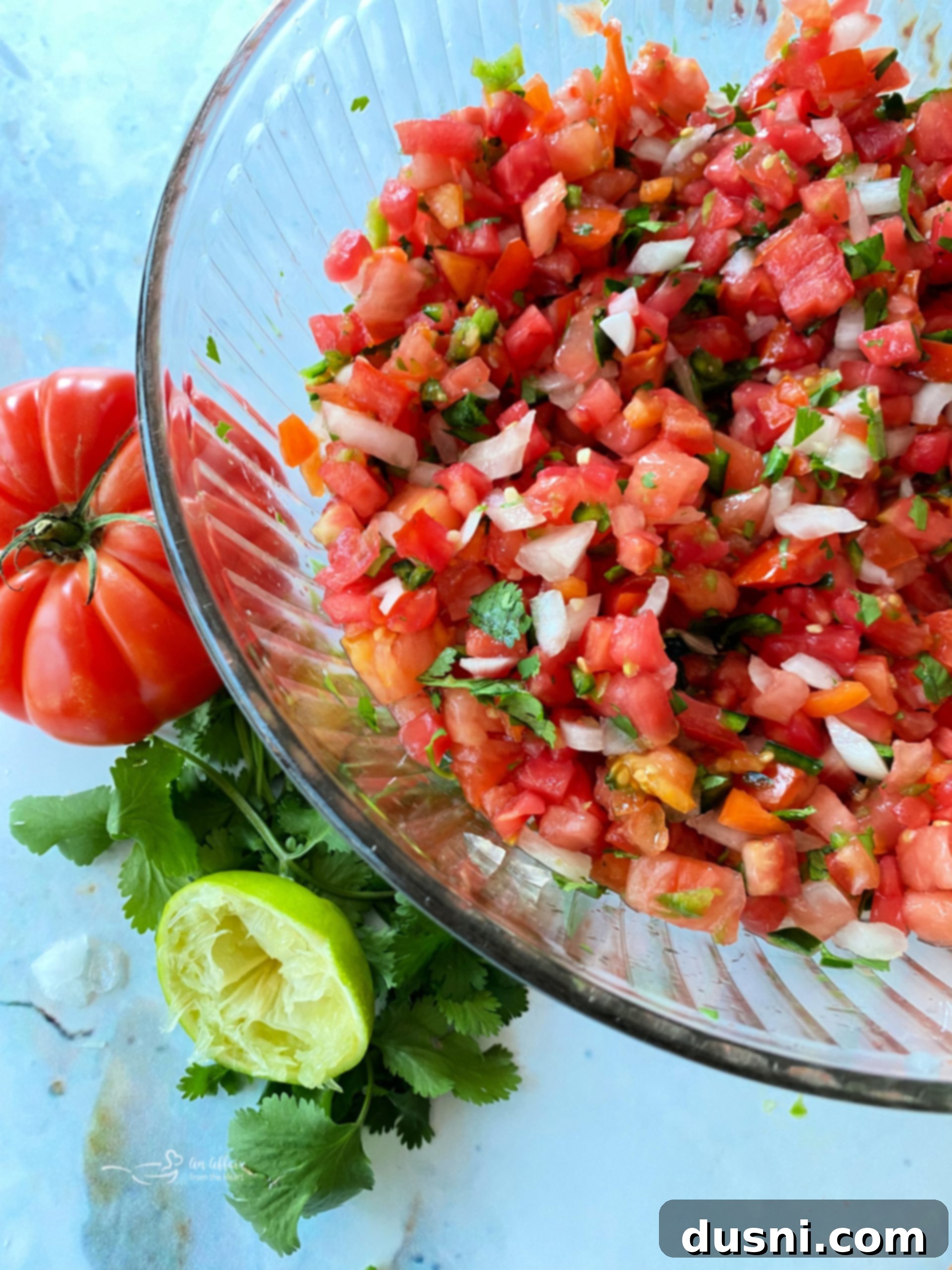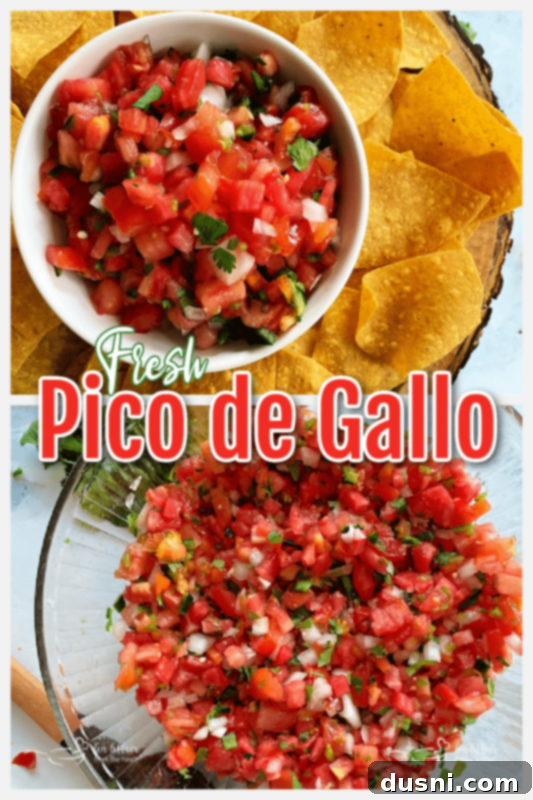Fresh & Authentic Pico de Gallo: The Ultimate Homemade Salsa Recipe Guide
Pico de Gallo is a vibrant, fresh salsa that stands out with its bold flavors and delightful chunky texture. It brings together the very best of garden-fresh ingredients: ripe, juicy tomatoes, crisp onions, pungent garlic, and the lively kick of jalapeños, all brightened by a squeeze of fresh lime juice and fragrant cilantro. This easy-to-make condiment is incredibly versatile. While it’s famously paired with tortilla chips, its uses extend far beyond a simple dip. Imagine it gracing grilled chicken, fish tacos, scrambled eggs, or even transforming into a refreshing, zesty salad on its own. It’s a culinary staple that adds a burst of freshness and flavor to almost any dish, making it a must-have in your kitchen repertoire.
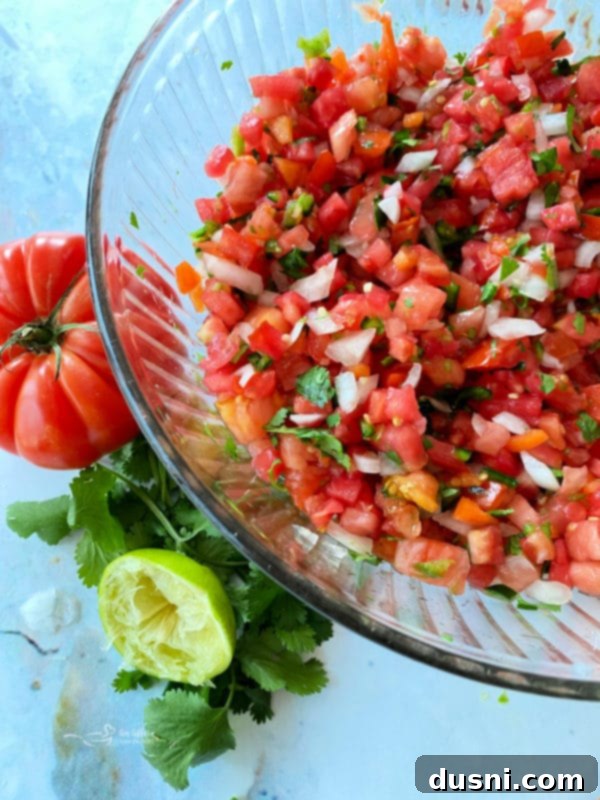
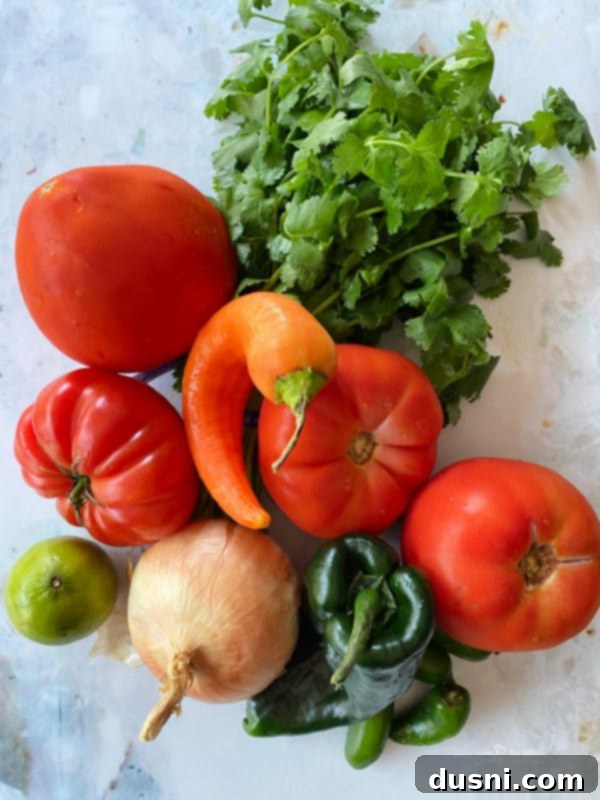
What Does “Pico de Gallo” Mean? Exploring the Name
The literal translation of “Pico de Gallo” from Spanish to English is “rooster’s beak.” This intriguing name often leaves people curious about its origin, as none of the common explanations seem to offer a definitive, widely accepted reason. However, several theories attempt to shed light on this culinary mystery. One popular theory suggests the name comes from the way the traditional salsa was eaten: by pinching small amounts between the thumb and forefinger, resembling a rooster pecking at its food. Another explanation refers to the texture and appearance of the finely chopped ingredients, which some believe are reminiscent of finely chopped bird feed or even the multicolored comb of a rooster. There’s also a theory that the slight spicy “bite” of the jalapeños in the salsa is comparable to a rooster’s peck. Regardless of its exact etymological roots, this recipe is quite ancient, with historical accounts tracing similar fresh salsas back to the time of the Aztec empire. The Spanish, upon encountering this remarkably tasty concoction, gave it a name that, for whatever reason, stuck through centuries, proving that sometimes, a name simply works, even if its literal meaning remains a delightful enigma.
Pico de Gallo vs. Salsa: Understanding the Key Differences
While it’s true that pico de gallo is fundamentally a type of salsa – specifically, a “salsa fresca” or fresh salsa – there are distinct characteristics that differentiate it from other, more general types of salsa. The primary distinction lies in its texture and preparation method. Pico de gallo is renowned for its fresh, chunky consistency, where all the ingredients are finely diced by hand or with minimal processing, allowing each component to retain its individual integrity. The “sauciness” of pico de gallo comes directly from the natural juices released by these freshly chopped ingredients, particularly the tomatoes and lime. It’s often served immediately after preparation or after a short chill, emphasizing its vibrant, raw flavors.
In contrast, the broader category of “salsa” encompasses a vast array of preparations. Many salsas are more liquid or puréed, often involving cooking, roasting, or blending ingredients to achieve a smoother consistency. They can be thin or thick, mild or extremely spicy, and can feature cooked tomatoes, tomatillos, or various fruits and vegetables. Common salsas might include cooked red salsas (salsa roja), roasted tomatillo salsas (salsa verde), or even fruit-based salsas. The lack of cooking and the emphasis on a rustic, diced texture are what truly set pico de gallo apart as a specific, beloved variation within the diverse world of Mexican salsas. While the core ingredients of pico de gallo remain fairly standard—tomatoes, onions, jalapeños, lime juice, and cilantro—there can be regional variations. For example, some traditions might include specific types of peppers or different citrus. As for me, I’m a firm believer in the addition of garlic; it contributes a wonderful depth of flavor and a subtle “bite” without necessarily increasing the heat, balancing the other fresh components beautifully. Others may prefer to omit it, but for my taste buds, it’s an indispensable element.

Essential Ingredients for Easy Homemade Pico de Gallo
Creating an outstanding Pico de Gallo relies on the quality and freshness of its simple ingredients. Each component plays a crucial role in building the layered flavors and vibrant texture that define this classic fresh salsa. Here’s a closer look at what you’ll need and why:
- Ripe Tomatoes: These are the star of pico de gallo. Choose firm, ripe, and juicy tomatoes such as Roma, beefsteak, or even cherry tomatoes (if you’re willing to chop many small ones). The natural sweetness and acidity of fresh tomatoes form the base of the salsa, providing both flavor and a good portion of its moisture.
- Onions: Yellow onions are commonly used for their balanced flavor, but white onions offer a sharper, more traditional kick. Red onions can also be used for a milder taste and beautiful color. They add a crucial pungent crunch and depth to the salsa.
- Fresh Cilantro: This herb is indispensable, providing a distinctive fresh, citrusy, and slightly peppery aroma. For those who find cilantro soapy (a genetic predisposition), fresh parsley can be a substitute, though it will change the flavor profile significantly.
- Garlic: While some traditional recipes omit it, I find minced garlic adds an incredible layer of savory depth and a subtle spicy edge that truly elevates the overall flavor profile without adding excessive heat.
- Jalapeño Peppers: These provide the characteristic heat. For a milder pico de gallo, remove the seeds and membranes, as this is where most of the capsaicin (the heat compound) resides. For more heat, leave some or all of them in. The jalapeños also contribute a fresh, slightly green pepper flavor.
- Lime Juice: Freshly squeezed lime juice is non-negotiable. It provides the essential bright, tart acidity that balances the sweetness of the tomatoes and the heat of the peppers. It also acts as a natural “cooker,” slightly softening the onions and blending all the flavors.
- Optional Additional Peppers: For those who love to experiment with flavor and texture without necessarily adding more intense heat, incorporating other diced peppers can be a wonderful idea. I often add in a cup of diced colored bell peppers (red, yellow, orange) for their vibrant hues and sweet crunch. Sometimes, I opt for banana peppers for a milder, tangy note, or a poblano pepper, which offers an earthy, smoky undertone. These additions enhance the complexity and visual appeal of the pico without overwhelming the palate with extra spice.
- Pinch of Sea Salt: Salt is vital for seasoning and bringing out all the natural flavors of the fresh ingredients. Always add it to taste, adjusting as needed after the ingredients have had a chance to meld.
Simple in its components and incredibly easy to assemble, Pico de Gallo is the perfect fresh salsa you can whip up in minutes whenever the craving strikes or you need a versatile condiment. Beyond its classic pairing with tortilla chips, its bright, zesty profile makes it an exceptional topping. Try it on flaky white fish like salmon or cod for a refreshing contrast, or spoon it over grilled chicken or steak for an instant flavor boost. It’s fantastic stirred into burritos or burrito bowls, and you can even mix it with some refried beans to create a zesty bean dip or sauce. The options are truly endless, making pico de gallo a staple for any meal.
How to Make the Perfect Homemade Pico de Gallo
Making Pico de Gallo is a straightforward and rewarding process. The key to its vibrant flavor and perfect texture lies in thoughtful preparation and the quality of your fresh ingredients. Follow these simple steps to create a delicious homemade salsa that will impress everyone:
Step 1: Gather and Prepare Your Ingredients (Mise en Place)
First and foremost, get all your ingredients ready and laid out before you begin chopping. This culinary principle, known as “mise en place,” meaning “everything in its place,” is crucial for a smooth and enjoyable cooking experience. Having everything right there in front of you—washed, measured, and prepped—not only makes the chopping process more efficient but also ensures an easier cleanup afterward. It allows you to focus solely on the art of dicing and combining, guaranteeing a more relaxing and successful outcome for your fresh salsa.

Step 2: Expert Chopping for Perfect Texture
Next, dive into the chopping! This is where the characteristic chunky texture of pico de gallo comes to life. You want to aim for pieces small enough to be easily scooped onto a tortilla chip, but not so fine that they become mushy. A consistent, fine dice is key to allowing all the distinct flavors to blend properly without any single ingredient overpowering the others. While I often use my food processor for the more robust items like peppers and onions—and sometimes even the cilantro for a quicker chop—I always prefer to dice my tomatoes by hand with a sharp knife. This ensures cleaner cuts, minimizes bruising, and prevents the tomatoes from becoming watery, preserving their fresh integrity in the salsa.
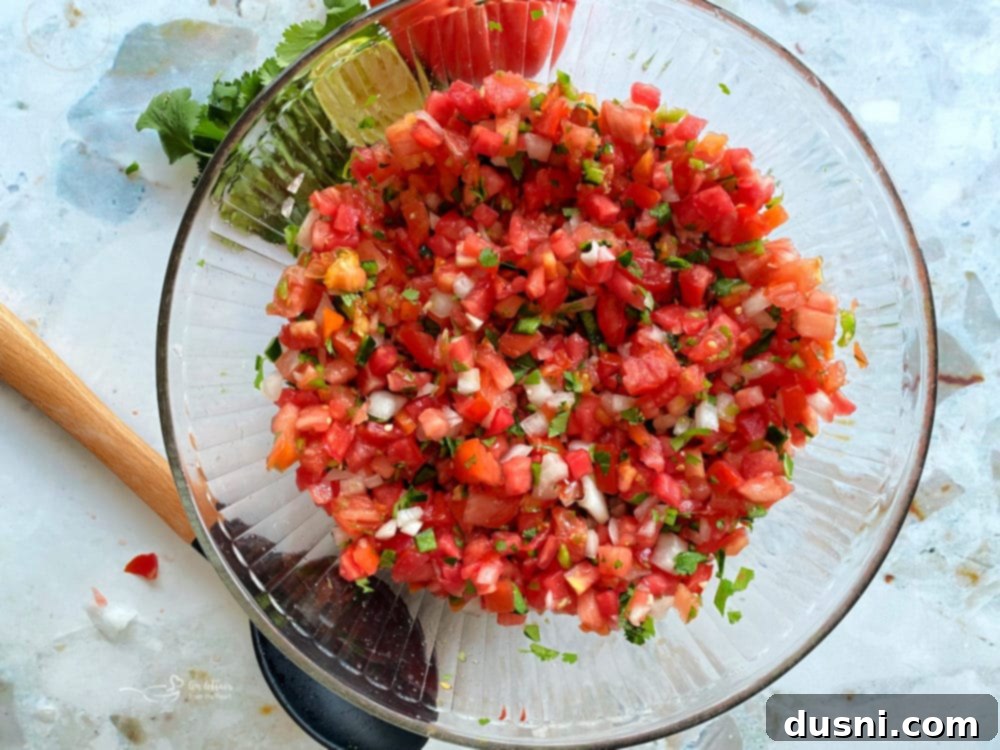
Step 3: Gently Combine and Blend Flavors
Once everything is finely chopped, it’s time to bring all those beautiful ingredients together. Go ahead and combine the diced tomatoes, onions, peppers, garlic, and cilantro in a large bowl. Give it a good, gentle stir to ensure everything is evenly distributed. You want to mix thoroughly enough for the flavors to start interacting, but avoid over-mixing or beating it up too much, which can crush the delicate ingredients and release too much moisture. The goal is to maintain that fresh, chunky texture that makes pico de gallo so appealing. This initial mix is where the magic begins, as the individual components begin to harmonize.
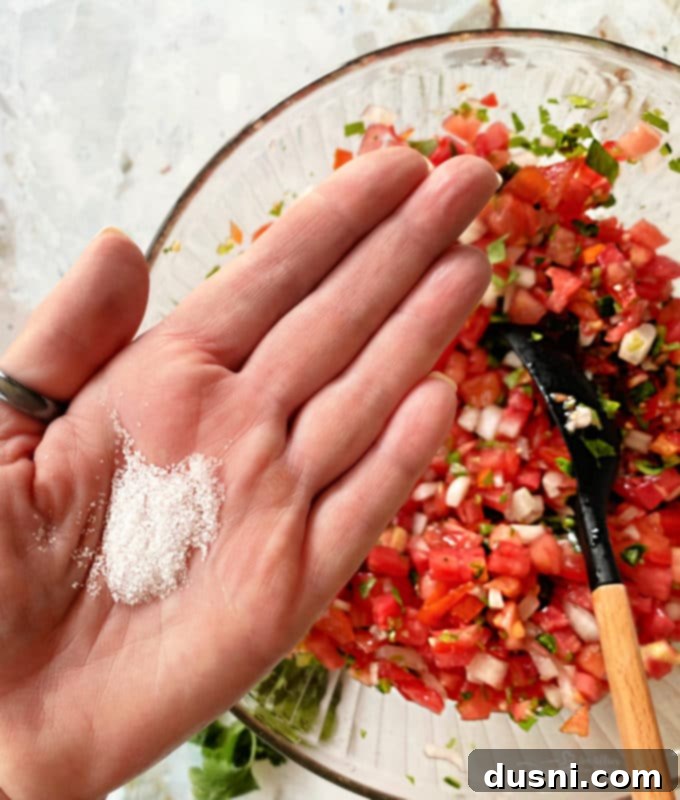
Step 4: The Finishing Touch – Lime and Salt
Now, for the essential brightening agents! Add the freshly squeezed lime juice to the mixture. The vibrant acidity of the lime is crucial; it not only brightens all the flavors, making them pop, but also helps to balance the heat from the peppers and tenderize the onions slightly. It acts as a natural preservative, too. After incorporating the lime, it’s time to add salt to taste. Sea salt is often preferred for its clean flavor. Start with a pinch, stir, and then taste. Adjust as needed until the flavors are perfectly balanced to your preference. This step brings the entire salsa together, enhancing the natural deliciousness of each ingredient.

Step 5: Chill for Enhanced Flavors
While your pico de gallo is ready to eat right away, its flavors truly deepen and meld beautifully after it sits for a few hours in the fridge. This chilling period allows the various ingredients to “shake hands and get along together,” as the juices mingle and the vibrant individual notes harmonize into a more cohesive and delicious symphony. Overnight chilling is even better, letting the flavors fully develop and intensify. Cover the bowl tightly and refrigerate until you’re ready to serve this fresh, flavorful salsa!
Love This Recipe? Pin It for Later!
If you’re as excited as I am to make this incredible Pico de Gallo recipe, make sure you can easily find it whenever the craving strikes! Don’t let this fresh and flavorful salsa get lost in your bookmarks. Pin it to your favorite Pinterest recipe board right now so it’s always just a click away when you’re ready to chop, mix, and enjoy!
Is Pico de Gallo a Healthy Choice? Absolutely!
Far from being just another tasty condiment, pico de gallo is an incredibly healthy addition to your diet. In a world where many condiments are laden with sugars, unhealthy fats, and artificial ingredients, fresh pico de gallo stands out as a beacon of nutrition. It’s packed with an abundance of essential vitamins, minerals, and powerful antioxidants, making it a fantastic choice for boosting your overall wellness.
- Tomatoes: Rich in Vitamin C, potassium, and lycopene, a potent antioxidant known for its potential to reduce the risk of certain cancers and protect skin from sun damage.
- Onions: Provide Vitamin C, B vitamins, and powerful antioxidant compounds like quercetin, which has anti-inflammatory properties and supports heart health.
- Jalapeños: Contain capsaicin, the compound responsible for their heat, which is known to boost metabolism, act as a natural pain reliever, and possess anti-inflammatory benefits. They are also a good source of Vitamin C.
- Garlic: When crushed and chopped, garlic releases allicin, a powerful sulfur compound with well-documented antibiotic and antimicrobial properties. Historically, garlic was a primary antibiotic before the advent of penicillin, highlighting its immense health benefits, particularly for immune support.
- Cilantro: A detoxifying herb packed with antioxidants, Vitamin K, and Vitamin A. It’s believed to help remove heavy metals from the body and support digestive health.
- Lime Juice: An excellent source of Vitamin C, which is vital for immune function, skin health, and acting as an antioxidant. It also aids digestion and can contribute to hydration.
Together, these ingredients create a powerhouse of nutrients, making pico de gallo an anti-inflammatory, immune-boosting, and incredibly fresh way to add flavor to your meals.
Can You Freeze Pico de Gallo? Tips for Texture Preservation
Yes, you can freeze pico de gallo, and it’s a great way to preserve a bountiful harvest or an extra-large batch. However, it’s important to manage expectations regarding the texture, particularly of the tomatoes. Tomatoes have a high water content, and when frozen, these water molecules expand, creating ice crystals that can break down the cell walls. Upon thawing, this often results in a softer, somewhat “mealy” texture for the tomatoes, and the salsa may release more liquid. But don’t worry, this doesn’t mean your frozen pico de gallo is ruined!
To best freeze it, transfer the pico de gallo into freezer-safe bags or airtight containers, leaving a little headspace for expansion. When you’re ready to enjoy it, thaw it in the refrigerator. Once thawed, you might find it beneficial to gently drain any excess liquid that has accumulated. The most effective trick to restore its fresh appeal is to chop in some additional fresh tomatoes and a sprinkle of fresh cilantro just before serving. This infuses new life, vibrant texture, and a burst of fresh flavor back into the thawed salsa, making it perfectly enjoyable once more.
How Long Does Pico de Gallo Last? Storage and Fermentation Insights
Thanks to the natural preservative qualities of its ingredients, pico de gallo actually keeps quite well in the refrigerator. The acidity from the lime juice, combined with the antimicrobial properties of the garlic and onions, creates an environment that is very resistant to mold and undesirable bacterial contamination. When stored properly in an airtight container in the fridge, your homemade pico de gallo can last for up to three weeks.
Over time, especially after a week or two, you might notice a slight change in the flavor profile—a subtle tanginess or effervescence. This is often a sign of mild fermentation occurring, a natural process for fresh, raw ingredients. This fermentation is generally not an indication that the pico de gallo has “gone bad” in a harmful way. While some people might not prefer the slightly fermented quality of the flavor, it is still perfectly safe and often delicious to eat. Just be sure to use your senses: if you see any obvious mold, smell any off-putting odors, or notice extreme discoloration, it’s always best to err on the side of caution and discard it. Otherwise, enjoy your long-lasting, flavor-developing fresh salsa!
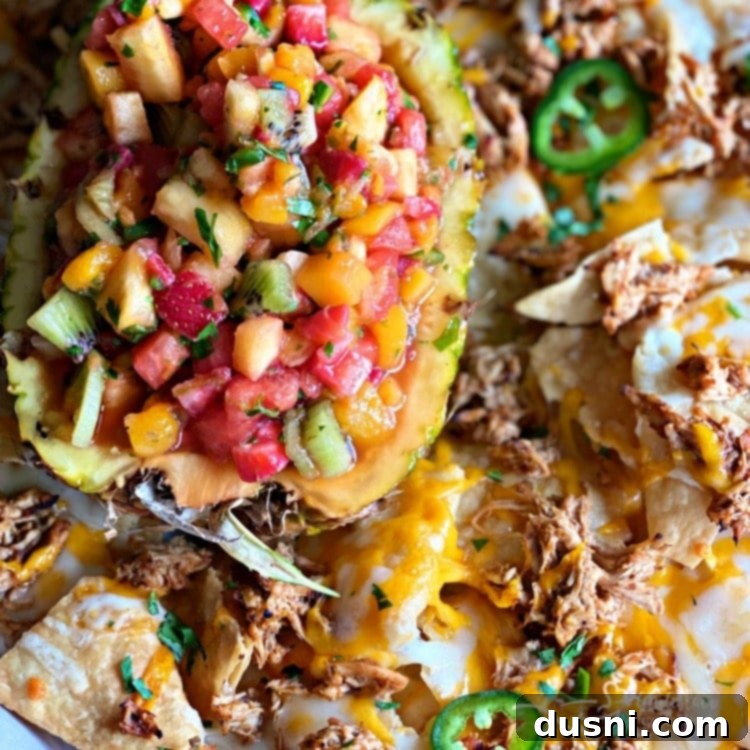
More Delicious Salsa Recipes to Explore
If you’ve fallen in love with the vibrant flavors of Pico de Gallo, you’re in for a treat! The world of salsa is incredibly diverse and offers a variety of textures and tastes to explore. From smooth and smoky to sweet and fruity, there’s a salsa for every occasion and palate. Expand your culinary horizons with these other fantastic salsa recipes:
- Blender Salsa: Quick, easy, and perfect for when you need a smooth salsa in a flash.
- Tropical Salsa (pictured above): A sweet and savory delight, perfect for adding an exotic touch to grilled dishes or nachos.
- Cucumber Salsa: Refreshing and crisp, ideal for cooling down spicy dishes or serving as a light dip.
- Roasted Tomatillo Salsa (Salsa Verde): A classic green salsa with a tangy, smoky depth from roasted tomatillos.
- Apple Pie Salsa: An unexpected but delightful sweet salsa, perfect for desserts or a unique appetizer.
- Copy Cat El Chico Salsa: Recreate the beloved restaurant-style salsa right in your own home.
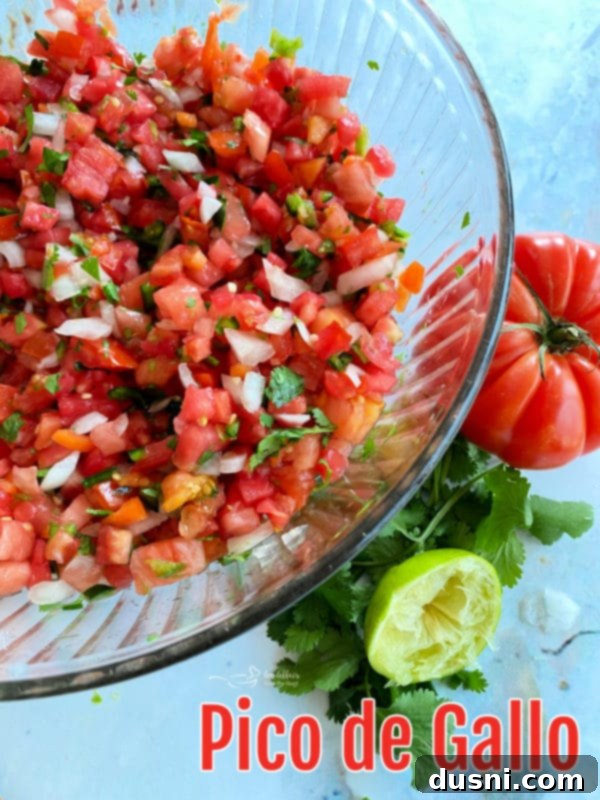
There’s truly nothing quite like the taste of summer captured in a bowl. So, gather those bountiful garden-fresh tomatoes and vibrant peppers, along with all the other amazing ingredients, and let’s make some glorious Pico de Gallo! Enjoy the process, savor the flavors, and delight in the freshness of this incredible homemade salsa. 
LIKE THIS RECIPE?
Don’t forget to give it a ⭐️⭐️⭐️⭐️⭐️ star rating and
leave a comment below the recipe!

Print Recipe
Pico de Gallo
Equipment
-
12-Piece Black Sharp Knife Set with Covers, Cutting Board and Sharpener
-
Cuisinart DLC-2ABC Mini-Prep Plus 24-Ounce Food-Processors, 3 Cup, Brushed Chrome and Nickel
-
Ninja BN601 Professional Plus Food Processor 9-Cup Capacity and a Silver Stainless Finish
Ingredients
- 4 large sized ripe tomatoes diced (about 7-8 cups)
- 1- 1 1/2 yellow onion diced (about 1 1/4 cups )
- 1-2 jalapeños deveined and seeded, chopped fine for less heat, or include seeds for more spice
- 2 cloves garlic minced
- juice of one lime freshly squeezed is best
- 1/2 cup fresh cilantro leaves chopped, or adjust to taste
- I like to add in another cup of diced peppers Consider colored bell peppers for sweetness, banana peppers for mild tang, or poblano pepper for earthy flavor. This is more for flavor and color, not for intense heat.
- sea salt to taste, enhancing all the fresh flavors
Instructions
-
Carefully dice your ripe tomatoes and onions into uniform, small pieces. Transfer them into a large mixing bowl.
-
In your food processor, place the seeded jalapeño peppers (and any additional peppers you choose) and fresh cilantro leaves. Pulse them together until finely chopped but not puréed. Scoop this mixture into the bowl with the tomato and onion.
-
Add the minced garlic and freshly squeezed lime juice to the bowl. Give it a generous sprinkle of sea salt. Stir everything gently but thoroughly to combine all the ingredients and ensure the flavors begin to meld.
-
For the best flavor, refrigerate your pico de gallo for at least 5 hours. Allowing it to chill overnight is even better, as this gives ample time for all the vibrant flavors to fully develop and harmonize.
Nutrition
This recipe was originally posted on August 7, 2013. It has been thoroughly updated and expanded to improve user experience, enhance SEO, and provide more comprehensive information, and reshared on September 1, 2021.
